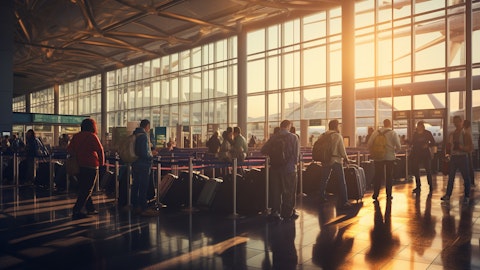So overall seasonality momentum was, momentum was great. But specific to your question, was there anything extraordinary, I won’t say there was anything extraordinary or temporary in nature. The mix, if you will see our overall mix of revenue on revenue basis contribution coming in from the hotel and packages has improved from 40% to 45% now, which is great. And that is on the back of the overall sort of mix changing. But from a demand in general standpoint, all segments actually that we saw demand going up and I guess additionally the emerging trend on homestays specifically has also started helping because that has added on one side a new set of supply and also new demand use cases that have also emerged off late, which has added momentum to the overall demand on the hotel and accommodation side and within packages.
We saw outbound packages sort of coming back in this quarter with the bang as well. So I would say overall it’s a bunch of factors, but lot more on the demand side and sort of all segments sort of rising, which is helping the overall hotel and packages business grown this quarter.
Vijit Jain: Rajesh, just staying on that hotels thing, do you have any comment to make on in general the demand and the supply situation, at least on the premium hotel or the branded hotel space in India? How do you think that evolving and do you think ADRs therefore remain resilient or even go up further from here? And a related question to that, do you think that is kind of, at least in that segment, impacting or bringing some shift over into the international outbound side from India. You did mention international outbound is doing very well. So I’m just wondering if you’re seeing some kind of a shift there and how does that affect you in general?
Rajesh Magow: Yes. No, so I think it’s a good question. So if you look at past couple of quarter’s data or more, and the ideas [ph.] on the premium segment, I would say even on the mid segment have been fairly robust. But I think we should never forget sort of factoring in the two years lull period where there was, thanks to COVID, there was no real price increase on the hotel side on all segments that had happened. So if you factor that in and adjust it to sort of overall cumulative inflation, normal inflation for last, I would say, say about three years, you would realize that the price increase is about 10%, which is fairly reasonable in my view. I don’t see this sort of as an exceptional price increase, excepting for certain days where there will be exceptional demand over the long weekends, etcetera.
That would always be the case because there will be more demand and less supply. And then because of that gap, there could be increase in prices, which to my mind is very normal, and that happens in any market. But otherwise, I think there is a certain degree of stability in pricing in terms of the new base that is setting in the market, and which I think is sustainable in an overall level. Now, outside of that, I think it will be a function of whether it will further increase from here or sort of sometimes in the market where in certain weeks, certain weekends, certain around the events, etcetera, the prices could go more or could go less will be a function of how much demand and how much, what’s the sort of demand and supply gap equation that works out.
But it’s going to be a very normal sort of up and down that we would see. I think there is a new base that is set up where from a demand standpoint, we’ve seen, customers in general sort of upgrading on the back of, I think it’s a behaviour change that we have noticed in terms of maybe taking more holidays or maybe spending more percentage of the available disposable income in consumers’ pocket to experience travel, which means more demand in the market. So there is definitely more upside on the demand, which is helping. And therefore, and within that, I think it’s also a behaviour of, upgrading from a particular segment to the next level and for a mid-segment to let’s say a premium segment. And last point I would make on this also is that, it has also, specifically to premium segment, lot of the non-leisure travel events, like whether it is the corporate offsides or, specifically the mice activities or for that matter, weddings, that during the season, more and more you see the trend of these events happening in the hotels.
And because of which, obviously, there is more demand relative to the historical period. And that’s also sort of helping, sustaining the price levels that you would typically see or are seeing in the market. But I think all the factors will have to be brought together to analyse and jump to conclusion in terms of what kind of, whether this is sort of sustainable or not. In my view, there is at certain level that these are sustainable with plus minus 5% 10% up and down that will happen, which will be a function of regular demand and supply gap.
Vijit Jain: Got it, Rajesh. My last question, just on the international outbound from India, if you can give any colour on where you’re seeing, in terms of channels, at least where you’re seeing growth from, is it coming more in the packages side? Or because you also have direct, holiday booking feature available on your platform. And then there’s the travel agent business also that you do. So I’m just wondering where do you see the most momentum overall? My question is more on the international outbound side, but maybe if the answer is relevant and domestic as well, you can answer that. Thank you.




